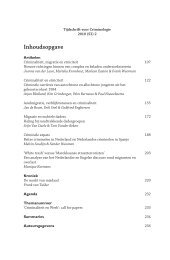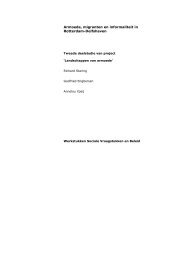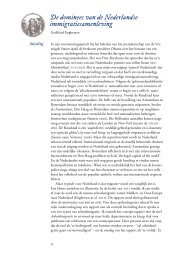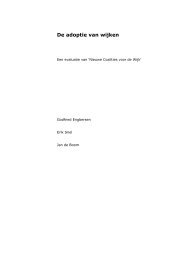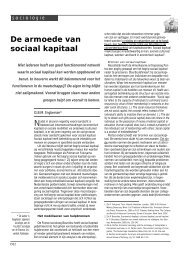THE SOCIAL CONSTRUCTION OF ILLEGALITY AND CRIMINALITY ...
THE SOCIAL CONSTRUCTION OF ILLEGALITY AND CRIMINALITY ...
THE SOCIAL CONSTRUCTION OF ILLEGALITY AND CRIMINALITY ...
You also want an ePaper? Increase the reach of your titles
YUMPU automatically turns print PDFs into web optimized ePapers that Google loves.
2<br />
GODFRIED ENGBERSEN <strong>AND</strong> JOANNE VAN DER LEUN<br />
changed radically. A pluralisation and fragmentation of migration is taking<br />
place. This ‘new migration’ is characterised by new geographical patterns<br />
of migration, new types of migrants with deviating legal statuses, who<br />
are dependent to some extent on other existence strategies than formal paid<br />
employment or social security (Koser and Lutz 1998; Snel et al. 2000).<br />
The new geography of migration relates primarily to the increased longdistance<br />
migration to Europe from a growing number of countries. In addition,<br />
we see that, within Europe, the traditional migration direction from<br />
South to North is complemented by migration flows from East to West. To<br />
some extent these altered migration flows become apparent in migration<br />
statistics. Between 1990 and 1997, in the Netherlands, the proportion of<br />
immigrants from other countries, both from non-industrialised Third World<br />
countries and various Central and Eastern European countries, rose from<br />
7–30% (SCP 1998, p. 241).<br />
The new migration also becomes visible in the increasing significance<br />
of new types of immigrants in addition to the traditional labour migrants<br />
and migrants from former colonies and their offspring. Firstly, there are<br />
the asylum seekers, whose number has increased dramatically since the<br />
mid-1980s (Muus 1999). Due to the length of the asylum procedures, many<br />
of them are kept in a state of suspension for considerable time as to whether<br />
or not they will acquire a permanent or temporary residence status. Secondly,<br />
there is an increasing flow of temporary immigrants from Central<br />
and Eastern Europe who travel back and forth to the countries of the European<br />
Union, Germany in particular. Thirdly, there is the relatively new<br />
type of immigrants known as undocumented or illegal immigrants. Many<br />
illegal immigrants came to Europe on a tourist visa and then stayed, others<br />
crossed the border illegally, and again others became illegal when they<br />
were refused refugee status. The dividing lines between asylum seekers,<br />
‘commuting’ immigrants and illegal immigrants often prove to be diffuse<br />
(Gächter et al. 2000). Relatively little is known about the size of the category<br />
of illegal immigrants (Delaunay and Tapinos 1998). Western European<br />
estimates run in the millions (Castles and Miller 1994, Widgren<br />
1999), 1 whereas Dutch estimates vary from approximately 50,000 illegal<br />
immigrants to 200,000 illegal immigrants. Our own estimates, in<br />
which illegal immigrants from Central and Eastern Europe were left out,<br />
1 The ICMPD (International Centre for Migration Policy Development) in Vienna<br />
maintains that the number of illegal immigrants who trespass the borders of Western<br />
European States for the sake of illegal employment or residence, could be estimated to<br />
be at least 400,000 in 1998 (Widgren 1999).



